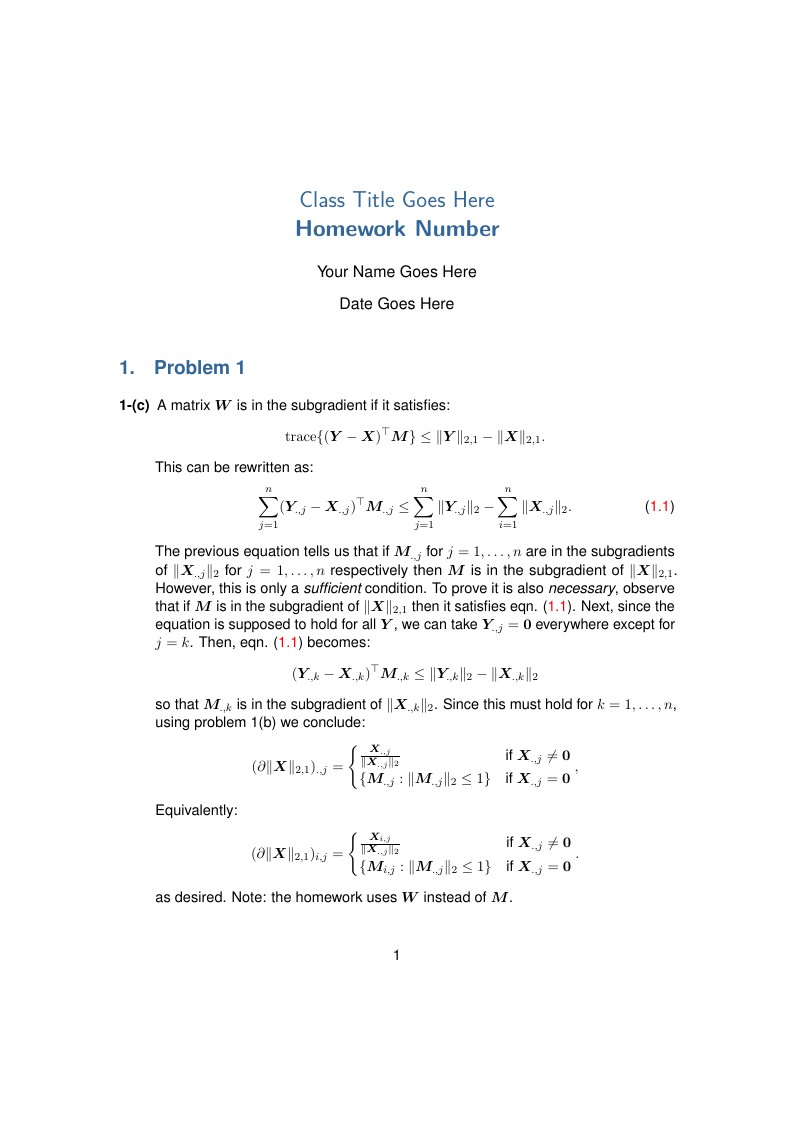
A homework template. Modified from Igor Shevtsov's template.

\documentclass[11pt,onside]{article}
\usepackage[a4paper]{geometry}
\usepackage[utf8]{inputenc}
\usepackage[english]{babel}
\usepackage{lipsum}
\usepackage{bm}
\usepackage{upgreek}
\usepackage{amsmath}
% mathtools for: Aboxed (put box on last equation in align envirenment)
\usepackage{microtype} %improves the spacing between words and letters
%% COLOR DEFINITIONS
\usepackage[svgnames]{xcolor} % Enabling mixing colors and color's call by 'svgnames'
\definecolor{MyColor1}{rgb}{0.2,0.4,0.6} %mix personal color
\newcommand{\textb}{\color{Black} \usefont{OT1}{lmss}{m}{n}}
\newcommand{\blue}{\color{MyColor1} \usefont{OT1}{lmss}{m}{n}}
\newcommand{\blueb}{\color{MyColor1} \usefont{OT1}{lmss}{b}{n}}
\newcommand{\red}{\color{LightCoral} \usefont{OT1}{lmss}{m}{n}}
\newcommand{\green}{\color{Turquoise} \usefont{OT1}{lmss}{m}{n}}
\DeclareMathOperator{\trace}{trace}
\DeclareMathOperator{\diag}{diag}
%% FONTS AND COLORS
% SECTIONS
\usepackage{titlesec}
\usepackage{sectsty}
%%%%%%%%%%%%%%%%%%%%%%%%
%set section/subsections HEADINGS font and color
\sectionfont{\color{MyColor1}} % sets colour of sections
\subsectionfont{\color{MyColor1}} % sets colour of sections
%set section enumerator to arabic number (see footnotes markings alternatives)
\renewcommand\thesection{\arabic{section}.} %define sections numbering
\renewcommand\thesubsection{\thesection\arabic{subsection}} %subsec.num.
%define new section style
\newcommand{\mysection}{
\titleformat{\section} [runin] {\usefont{OT1}{lmss}{b}{n}\color{MyColor1}}
{\thesection} {3pt} {} }
% CAPTIONS
\usepackage{caption}
\usepackage{subcaption}
%%%%%%%%%%%%%%%%%%%%%%%%
\captionsetup[figure]{labelfont={color=Turquoise}}
% !!!EQUATION (ARRAY) --> USING ALIGN INSTEAD
%using amsmath package to redefine eq. numeration (1.1, 1.2, ...)
\renewcommand{\theequation}{\thesection\arabic{equation}}
\makeatletter
\let\reftagform@=\tagform@
\def\tagform@#1{\maketag@@@{(\ignorespaces\textcolor{red}{#1}\unskip\@@italiccorr)}}
\renewcommand{\eqref}[1]{\textup{\reftagform@{\ref{#1}}}}
\makeatother
\usepackage{hyperref}
\hypersetup{colorlinks=true}
% For labeling top of page on every page but first one:
\usepackage{fancyhdr}
% PREPARE TITLE:
\title{\blue Class Title Goes Here \\
\blueb Homework Number}
\author{Your Name Goes Here}
\date{Date Goes Here} % You can set the date automatically by replacing "date goes here" with "\today"
\renewcommand{\rmdefault}{phv} % Arial Font
\renewcommand{\sfdefault}{phv} % Arial Font
\pagestyle{fancy}
\fancyhead{}
\fancyhead[CO,CE]{{\small{{\bf{Homework Number}} - Class Name - Semester - Your Name}}}
\begin{document}
\maketitle
\section{Problem 1}
\begin{description}
\item[1-(c)] A matrix $\bm{W}$ is in the subgradient if it satisfies:
\begin{align*}
\trace\{(\bm{Y}-\bm{X})^\top\bm{M}\}\leq \|\bm{Y}\|_{2,1}-\|\bm{X}\|_{2,1}.
\end{align*}
This can be rewritten as:
\begin{align}
\label{eq:necessary}
\sum_{j=1}^n(\bm{Y}_{.,j}-\bm{X}_{.,j})^\top\bm{M}_{.,j}\leq \sum_{j=1}^n\|\bm{Y}_{.,j}\|_2-\sum_{i=1}^n\|\bm{X}_{.,j}\|_2.
\end{align}
The previous equation tells us that if $\bm{M}_{.,j}$ for $j=1,\dots,n$ are in the subgradients of $\|\bm{X}_{.,j}\|_2$ for $j=1,\dots,n$ respectively then $\bm{M}$ is in the subgradient of $\|\bm{X}\|_{2,1}$. However, this is only a {\it{sufficient}} condition. To prove it is also {\it{necessary}}, observe that if $\bm{M}$ is in the subgradient of $\|\bm{X}\|_{2,1}$ then it satisfies eqn. (\ref{eq:necessary}). Next, since the equation is supposed to hold for all $\bm{Y}$, we can take $\bm{Y}_{.,j}=\bm{0}$ everywhere except for $j=k$. Then, eqn. (\ref{eq:necessary}) becomes:
\begin{align*}
(\bm{Y}_{.,k}-\bm{X}_{.,k})^\top\bm{M}_{.,k}\leq \|\bm{Y}_{.,k}\|_2-\|\bm{X}_{.,k}\|_2
\end{align*}
so that $\bm{M}_{.,k}$ is in the subgradient of $\|\bm{X}_{.,k}\|_2$. Since this must hold for $k=1,\dots,n$, using problem 1(b) we conclude:
\begin{align*}
(\partial\|\bm{X}\|_{2,1})_{.,j}=\begin{cases} \frac{\bm{X}_{.,j}}{\|\bm{X}_{.,j}\|_2} &\mbox{if } \bm{X}_{.,j}\neq \bm{0} \\
\{\bm{M}_{.,j}:\|\bm{M}_{.,j}\|_2\leq 1\} & \mbox{if } \bm{X}_{.,j}=\bm{0} \end{cases},
\end{align*}
Equivalently:
\begin{align*}
(\partial\|\bm{X}\|_{2,1})_{i,j}=\begin{cases} \frac{\bm{X}_{i,j}}{\|\bm{X}_{.,j}\|_2} &\mbox{if } \bm{X}_{.,j}\neq \bm{0} \\
\{\bm{M}_{i,j}:\|\bm{M}_{.,j}\|_2\leq 1\} & \mbox{if } \bm{X}_{.,j}=\bm{0} \end{cases}.
\end{align*}
as desired. Note: the homework uses $\bm{W}$ instead of $\bm{M}$.\\
\item[1-(d)] If we wish to minimize the objective function we first observe that the function is convex. In fact, it is {\it{strictly convex}} because the term $\|\bm{X}-\bm{A}\|_F^2$ is strictly convex in $\bm{A}$ and, as we have shown in 1(b), $\|\bm{A}\|_{2,1}$ is convex in $\bm{A}$. Furthermore, the sum of a strictly convex function and a convex function is again a strictly convex function. Therefore, our objective function has a {\underline{unique solution}}. Next, observe that the subgradient of our objective function is:
\begin{align*}
-(\bm{X}-\bm{A})+\uptau\partial\|\bm{A}\|_{2,1}.
\end{align*}
By part 1(c) we can further write the subgradient as:
\begin{align*}
-(\bm{X}-\bm{A})+\uptau\bm{M}
\end{align*}
where:
\begin{align}
\label{eq:subo}
\bm{M}_{.,j}=\begin{cases} \frac{\bm{A}_{i,j}}{\|\bm{A}_{.,j}\|_2} &\mbox{if } \bm{A}_{.,j}\neq \bm{0} \\
\{\bm{M}_{i,j}:\|\bm{M}_{.,j}\|_2\leq 1\} & \mbox{if } \bm{A}_{.,j}=\bm{0} \end{cases}.
\end{align}
Recall that a matrix $\bm{A}^\ast$ is a minimizer of our objective function if the subgradient of the objective function at $\bm{A}^\ast$ contains the matrix $\bm{0}$. This can be written as:
\begin{align}
\label{eq:sat}
\uptau\bm{M}=(\bm{X}-\bm{A}^\ast)
\end{align}
for some matrix $\bm{M}$ defined by eqn. (\ref{eq:subo}). Now, since we have already shown the objective function has a unique minimizer, all we must do is plug in the suggested solution for $\bm{A}^\ast$ and see if it satisfies eqn. (\ref{eq:sat}). Plugging in:
\begin{align*}
(\bm{X}-\bm{A}^\ast)_{.,j}&=[\bm{X}-\bm{X}\mathcal{S}_{\uptau}(\diag(\bm{x}))\diag(\bm{x})^{-1}]_{.,j}\\
&=\begin{cases} \uptau\frac{\bm{X}_{.,j}}{\|\bm{X}_{.,j}\|_2}&\mbox{if } \|\bm{X}_{.,j}\|_2>\uptau \\
\bm{X}_{.,j}& \mbox{if } \|\bm{X}_{.,j}\|_2\leq \uptau
\end{cases}.
\end{align*}
if we assume $\uptau>0$. Now, observe that:
\begin{align*}
\|\bm{X}_{.,j}\|_2\leq \uptau \Rightarrow \bm{A}^\ast_{.,j}=\bm{0} \Rightarrow \|\uptau\bm{M}_{.,j}\|_2\leq \uptau
\end{align*}
subject to $\|\bm{M}_{.,j}\|_2\leq 1$. Consequently, we can take $\uptau\bm{M}_{.,j}=\bm{X}_{.,j}$ whenever $\|\bm{X}_{.,j}\|_2\leq \uptau$. In the other case, we have:
\begin{align*}
\|\bm{X}_{.,j}\|_2> \uptau\Rightarrow\bm{A}^\ast_{.,j}\neq\bm{0} \Rightarrow \uptau\bm{M}_{.,j}=\uptau\frac{\bm{X}_{.,j}}{\|\bm{X}_{.,j}\|_2},
\end{align*}
this shows that if we take:
\begin{align*}
\uptau\bm{M}_{.,j}=\begin{cases} \uptau\frac{\bm{X}_{.,j}}{\|\bm{X}_{.,j}\|_2}&\mbox{if } \|\bm{X}_{.,j}\|_2>\uptau \\
\bm{X}_{.,j}& \mbox{if } \|\bm{X}_{.,j}\|_2\leq \uptau
\end{cases},
\end{align*}
then eqn. (\ref{eq:sat}) is satisfied. Therefore, $\bm{A}^\ast=\bm{X}\mathcal{S}_{\uptau}(\diag(\bm{x}))\diag(\bm{x})^{-1}$ is the unique solution to our optimization problem.\\
\end{description}
\end{document}